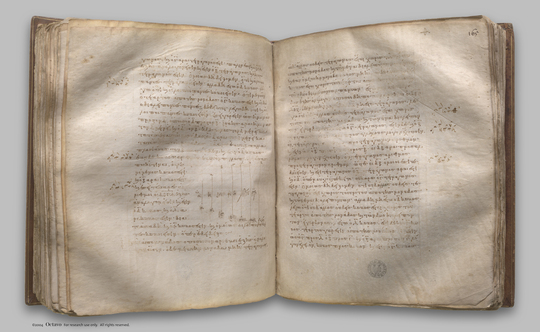index prev next | digilib folio 169

If as many numbers as we please beginning from an unit be in continued proportion, and the number after the unit be not square, neither will any other be square except the third from the unit and all those which leave out one.
| Ἐὰν ἀπὸ μονάδος ὁποσοιοῦν ἀριθμοὶ [ ἑξῆς ] ἀνάλογον ὦσιν, ὁ δὲ μετὰ τὴν μονάδα μὴ ᾖ τετράγωνος, οὐδ' ἄλλος οὐδεὶς τετράγωνος ἔσται χωρὶς τοῦ τρίτου ἀπὸ τῆς μονάδος καὶ τῶν ἕνα διαλειπόντων πάντων. καὶ ἐὰν ὁ μετὰ τὴν μονάδα κύβος μὴ ᾖ, οὐδὲ ἄλλος οὐδεὶς κύβος ἔσται χωρὶς τοῦ τετάρτου ἀπὸ τῆς μονάδος καὶ τῶν δύο διαλειπόντων πάντων. Ἔστωσαν ἀπὸ μονάδος ἑξῆς ἀνάλογον ὁσοιδηποτοῦν ἀριθμοὶ οἱ Α, Β, Γ, Δ, Ε, Ζ, ὁ δὲ μετὰ τὴν μονάδα ὁ Α μὴ ἔστω τετράγωνος: λέγω, ὅτι οὐδὲ ἄλλος οὐδεὶς τετράγωνος ἔσται χωρὶς τοῦ τρίτου ἀπὸ τῆς μονάδος [ καὶ τῶν ἕνα διαλειπόντων ]. Εἰ γὰρ δυνατόν, ἔστω ὁ Γ τετράγωνος. ἔστι δὲ καὶ ὁ Β τετράγωνος: οἱ Β, Γ ἄρα πρὸς ἀλλήλους λόγον ἔχουσιν, ὃν τετράγωνος ἀριθμὸς πρὸς τετράγωνον ἀριθμόν. καί ἐστιν ὡς ὁ Β πρὸς τὸν Γ, ὁ Α πρὸς τὸν Β: οἱ Α, Β ἄρα πρὸς ἀλλήλους λόγον ἔχουσιν, ὃν τετράγωνος ἀριθμὸς πρὸς τετράγωνον ἀριθμόν: ὥστε οἱ Α, Β ὅμοιοι ἐπίπεδοί εἰσιν. καί ἐστι τετράγωνος ὁ Β: τετράγωνος ἄρα ἐστὶ καὶ ὁ Α: ὅπερ οὐχ ὑπέκειτο. οὐκ ἄρα ὁ Γ τετράγωνός ἐστιν. ὁμοίως δὴ δείξομεν, ὅτι οὐδ' ἄλλος οὐδεὶς τετράγωνός ἐστι χωρὶς τοῦ τρίτου ἀπὸ τῆς μονάδος καὶ τῶν ἕνα διαλειπόντων. Ἀλλὰ δὴ μὴ ἔστω ὁ Α κύβος. λέγω, ὅτι οὐδ' ἄλλος οὐδεὶς κύβος ἔσται χωρὶς τοῦ τετάρτου ἀπὸ τῆς μονάδος καὶ τῶν δύο διαλειπόντων. Εἰ γὰρ δυνατόν, ἔστω ὁ Δ κύβος. ἔστι δὲ καὶ ὁ Γ κύβος: τέταρτος γάρ ἐστιν ἀπὸ τῆς μονάδος. καί ἐστιν ὡς ὁ Γ πρὸς τὸν Δ, ὁ Β πρὸς τὸν Γ: καὶ ὁ Β ἄρα πρὸς τὸν Γ λόγον ἔχει, ὃν κύβος πρὸς κύβον. καί ἐστιν ὁ Γ κύβος: καὶ ὁ Β ἄρα κύβος ἐστίν. καὶ ἐπεί ἐστιν ὡς ἡ μονὰς πρὸς τὸν Α, ὁ Α πρὸς τὸν Β, ἡ δὲ μονὰς τὸν Α μετρεῖ κατὰ τὰς ἐν αὐτῷ μονάδας, καὶ ὁ Α ἄρα τὸν Β μετρεῖ κατὰ τὰς ἐν αὑτῷ μονάδας: ὁ Α ἄρα ἑαυτὸν πολλαπλασιάσας κύβον τὸν Β πεποίηκεν. ἐὰν δὲ ἀριθμὸς ἑαυτὸν πολλαπλασιάσας κύβον ποιῇ, καὶ αὐτὸς κύβος ἔσται. κύβος ἄρα καὶ ὁ Α: ὅπερ οὐχ ὑπόκειται. οὐκ ἄρα ὁ Δ κύβος ἐστίν. ὁμοίως δὴ δείξομεν, ὅτι οὐδ' ἄλλος οὐδεὶς κύβος ἐστὶ χωρὶς τοῦ τετάρτου ἀπὸ τῆς μονάδος καὶ τῶν δύο διαλειπόντων: ὅπερ ἔδει δεῖξαι. | If as many numbers as we please beginning from an unit be in continued proportion, and the number after the unit be not square, neither will any other be square except the third from the unit and all those which leave out one. And, if the number after the unit be not cube, neither will any other be cube except the fourth from the unit and all those which leave out two. Let there be as many numbers as we please, A, B, C, D, E, F, beginning from an unit and in continued proportion, and let A, the number after the unit, not be square; I say that neither will any other be square except the third from the unit <and those which leave out one>. For, if possible, let C be square. But B is also square; [IX. 8] [therefore B, C have to one another the ratio which a square number has to a square number]. And, as B is to C, so is A to B; therefore A, B have to one another the ratio which a square number has to a square number; [so that A, B are similar plane numbers]. [VIII. 26, converse] And B is square; therefore A is also square: which is contrary to the hypothesis. Therefore C is not square. Similarly we can prove that neither is any other of the numbers square except the third from the unit and those which leave out one. Next, let A not be cube. I say that neither will any other be cube except the fourth from the unit and those which leave out two. For, if possible, let D be cube. Now C is also cube; for it is fourth from the unit. [IX. 8] And, as C is to D, so is B to C; therefore B also has to C the ratio which a cube has to a cube. And C is cube; therefore B is also cube. [VIII. 25] And since, as the unit is to A, so is A to B, and the unit measures A according to the units in it, therefore A also measures B according to the units in itself; therefore A by multiplying itself has made the cube number B. But, if a number by multiplying itself make a cube number, it is also itself cube. [IX. 6] Therefore A is also cube: which is contrary to the hypothesis. Therefore D is not cube. |